|
I celebrate the 25 December as the beginning of the final days of the year - something I'm quite sentimental about. I don't mock the idea of New Year's resolutions. It's a time to give it a go, to be warm with each other, to forgive one's foolishness, to plan and to make an effort. For the first time ever, we celebrated à deux. Modern life sends friends and relatives both across the globe and across the continent. We must accept it. And it was very, very simple, special and quite lovely. 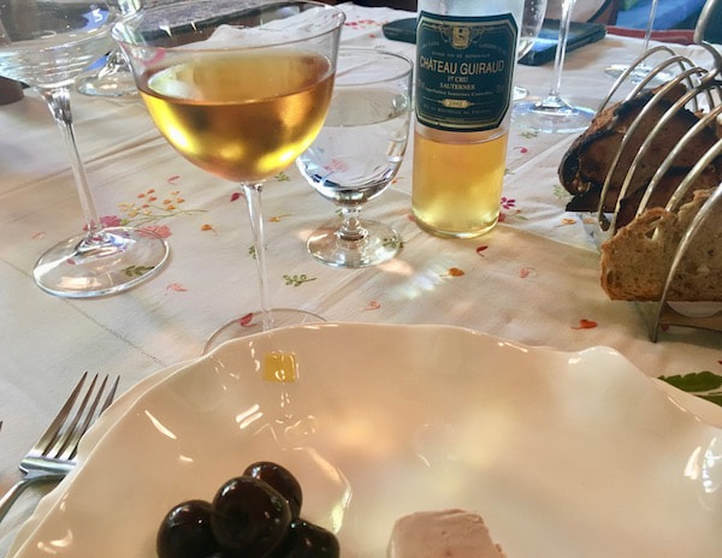 We set the table for two with a tablecloth embroidered by my mother. It's what French girls did in Algeria waiting for fiancés to claim them after the war. We had a modest petit-bourgeois sauternes, in possibly the world's most beautiful glass. (Joseph Hoffman, late 19th C., still available at Lobmeyr in Vienna.) Adam Wynn, retired winemaker and Honorary Japanese Consul relates that Philippe de Rothschild liked his sauternes so chilled that splinters of ice would tinkle against the glass. I've stuck to this although I think Phillipe might have drunk Chateau d'Yquem. This accompanied our mousseline de canard with sour-dough toast and pickled cherries ( from January this year). We moved to Champagne, Pol Roger 2008, a birthday present from October this year to RTV from his friend and "medical adviser" Dick W. Bliss to allow oneself to drink Champagne with a meal, not just before. Note to self - do this more often. (And drink less but better.) I love drinking in these possibly "incorrect" glasses, (bought in Hobart). It's festive to have the bubbles tickle your face. In keeping with the simplicity theme, we had garlic prawns (very 1970s but quick to prepare) with a little basmati and a tiny salad of our baby cos. To finish, a classic plum pudding, hot, with chilled custard. I'm not ashamed to say this was a pudding from Aldi and you couldn't have wished for better. I flamed it with over-proof dark rum. As you can see, I pour the custard around but RTV, the rugged individualist, pours his over, obliterating the pudding. He knows I dislike this but it's "party time" and to mimic Alan Bennett, "I didn't say anything".
But at this stage of the evening, things deteriorate a little and the laptop appears on the table. We reminisce, we draw out old dance numbers on Youtube, we rewatch some favourite comedy stand-ups. We drink water. Ah, well... (Cutlery - Portugal - Cutipol-Goa - approx. 2008) Comment, share or tick "like" - below (in very faint letters)
8 Comments
New home page to start off the new year of 2019. Wishing you sincerely a good try at contentment and fulfilment, some gatherings of friends away from phones and laptops and time to play with some of the great dishes and food combinations you've dreamed of.
This is a table set at home for a breakfast of friends. (We usually gather at different spots around town.) The simplest thing was to do the full English, accompanied by a glass of bubbles. This Wedgwood service (1910) offers me breakfast cups, teacups and coffee cups. So sensible. More of the breakfast later.  There has been some serious fallout from my Panettone disaster. Reactions have been swift and direct. Misunderstanding could be blamed on my poor writing and communication skills. I'll be more clear. I love Panettone but as with tins of "British" curry powder, jars of sweet soy-based mayonnaise, bottles of "lite" vinigerette (sic), tinned carrots, Kraft cheddar cheese slices, easy-squeeze plastic lemons of juice and bright green cocktail onions, I prefer the real thing. Silly me, I thought I'd make one. When I said this was the worst thing I'd ever made, a friend suggested it was simply that I didn't like panettone, that I had misunderstood that it was a type of a bread. No. I had tried and failed. This was awful because it was NOT a Panettone. This December I counted a minimum of 500 boxes of Panettone, displayed in pyramids, at any one time at my local supermarket. Every day the stacks were replenished. Imagine the number throughout this small city, in every supermarket, gourmet shop, Italian greengrocer, imagine the number in each city of the world. It's a bit like the diaspora of Persian Rug Closing Down Sales. I copied their ingredients. On average they were made of... Wheat flour, sugar, vegetable fats (palm oil) sultanas, eggs, natural yeast, candied orange peel, wheat glucose-fructose syrup, citric acid, sulphur di-oxide, emulsifying agents: mono & diglycerides of edible fatty acids, salt, skimmed milk powder, flavours (unspecified). They ranged in price, the lowest for a 900gram loaf was $6.49. Yes, there are good quality ones. The priciest was $47.00 and why shouldn't they charge that for something that has been made with care and good ingredients? Interestingly, these were not as tall (less pumped up) and with ingredients we could recognise. Yes I decided to make one and learnt it was harder than I imagined - a great lesson in humility. Another friend said it must have been OK because she knew I couldn't make anything bad. A darling and sweet thing to say, thank you, but I assure you, even I make (and have made) mistakes. Another friend said it looked yummy, Fool, you have many disappointments to look forward to. Still another found the worst thing was the garnish of holly. And here I was thinking I was being sarcastically funny decorating it with black leaves - a doomed loaf. 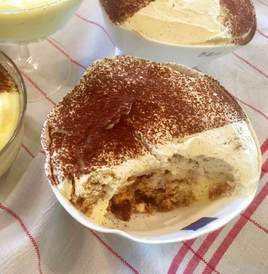 But solid information came from Frank. A master baker, Frank is the man. I re-post his notes which will open up some of the hidden traps of working with flour and yeast. (And I turned the loaf into a re-constructed Tiramisu, with the addition of coffee, over-proof dark rum and mascarpone cream. Frank writes, "Any yeast dough that has a high fat content and high sugar content needs to have a pre-batter stage. In a mixer, have some of the flour and a pinch of the sugar with all of the yeast and all of the liquid at blood temperature. Make this like a loose pancake batter and then cover with the rest of the flour, sugar, butter, salt and flavourings. When the batter rises up and causes the flour to crack open you know it’s ok to start mixing. Fruit goes in last after the dough is well developed. Don’t over-do the amount of alcohol you might be tempted to douse the fruit in either. High alcohol content can hinder the yeasts performance too. As for salt, it plays a very important part in any yeast product, in flavour and yeast management (stops the yeast from behaving like a teenage boy in love making). It also helps crust colour. I hope this helps Cath. Good on you for giving it a go though. Hope you try again with better results." Comment, share or tick "like" - below (in very faint letters) - You know you want to. Black Holly Leaves of DoomThis is definitely the worst thing I've ever produced, the worst thing I've ever pulled from an oven, the worst miscalculation of any recipe I've ever tried.
I'm not wild about a commercial panettone. They are too airy and often with too much undefinable (i.e artificial) flavouring. So I did a lot of talking around and reading about its culture, history and preparation. I went from Paul Hollywood (British Scouser from The Great British Bake-Off) to Carol Field, Marcella Hazan and Pellegrino Artusi et al. It all seemed like a wank, a procedure aimed at making the cook feel important, admired and loved. Days of angst with three different fermentations and proofing! Rubbish! None of that. I understand pastry, I make brioche with my eyes shut, for me puff pastry replaces yoga. Instead of making panettone, I decided to make a festive, culturally sensitive, fruit-studded brioche. Culturally sensitive in that I wanted to stay away from any rebukes from my Italophile friends. You know how it goes, add one more mint leaf to a traditional risotto recipe and you'll be banned from the aperitivo for life. So instead, I ended up with this. What went wrong? It is literally inedible and I use the word correctly. It's as dry as if it had been made a week ago and left un-covered on the bench. Toasted this morning and buttered, it didn't improve and there's not much that can't be fixed with a good buttering. Analysis...
What do I learn?
What to do with this? Perhaps I'll make Tiramisu but is this allowed with messed-up brioche? I could make a trifle and be careful not to call it Zuppa Inglese. I'll also go buy a panettone. Apart from pride and ignorance, where did I go wrong? Comment below. I’m lucky to have a greengrocer who dares to stock artichokes. Some growers keep a small crop on the side, it seems, and some plants come from local back yards. To most people the fresh variety remains a mystery. I’ve been asked what they are and what you do with them. There’s a lot of fancy stuff on the grocers’ shelves that has little going for it, IMO. Dragon fruit? Gorgeous to look at but tasteless. Chokos? OK, plentiful on someone’s back fence but flavour ditto. I love artichokes. I love them for sensible reasons. I love them for shallow reasons. They are fun. They taste good. They’re easy to prepare for a spectacular outcome. They are strange, esoteric, arcane (great word). They are a great vehicle for sauces such as hollandaise, mayonnaise, vinaigrette. They are an excuse for an artichoke plate! They are healthy. (Gosh! Never thought I’d stoop so low. More later.) But most of all, I like them because they are slow to eat. They take time (like eating crabs), time to chat and lick your fingers. To prepare them, pull off perhaps the two bottom rows of very small petals, cut off the stem, discard. Cut off the top 3-4 cm and trim the rest of the leaves with scissors, just to neaten the globe. Have some water simmering with a cut lemon in it to help keep the artichoke's colour. Be warned. With all the trimming, there will be debris! Simmer in gently rolling water for at least 15 minutes. This is not the time for "modern" crunchy vegetables. Check they are very tender by piercing the bottom with a knife tip. Drain the artichokes up-side-down. Serve at room temperature, on a plate with a dipping bowl of sauce per person. (An artichoke plate, of course, is designed to hold the bulb, hold the sauce and also hold the discarded leaves in an orderly fashion.) How do you eat them? Now you've done the work, how do you get the reward?
Start at the bottom. Pull off a petal. You will eat only the soft base (the rest is inedible). Dip the end into your sauce. Now for the tricky part. Turn it over, concave down, and pull/scrape away the flesh with your lower teeth. (See my teethmarks, above.) Keep going round and around until you get to the hairy choke. (This is the part that becomes the flower.) With a small sharp knife, trim this away. (Often it will pull away easily.) You have now reached the prize - the artichoke heart. Voilà. OK, you're not going to be gorging yourself with this but the pleasure is not only the flavour but the slowness. (All this for just the tip, you ask. Surely saner and more ethical than hummingbirds' tongues.) Tick if this helps. Tell me how you go. Comment or add to the conversation, below. Left: Artichoke bush in the garden. Right: Atichoke, grown huge and spiky, just ready to bloom. Artichokes are thistles and left on their bush long enough, the buds become huge, tough and spiky, developing the purple flower we associate with Scottish kilts, Laphroaig and Sean Connery. We buy the young, underdeveloped buds. They can be green, purple, round or pointed. When we first arrived in Australia (Ten Pound Poms, French mother) my mother took us out to pick tiny wild artichokes. Well of course, they were thistles - and delicious they were, too. Jerusalem Artichokes are a lovely tuber dug from the roots of a type of sunflower. They bear no relation to the artichoke. The English names are very confusing. In French, there are artichauts and topinambours, respectively. In Italian there are carciofi and topinambur. Hoping one day someone will make me artichaut à la juive or carciofi alla giudia, an old Jewish recipe from Rome. Whole artichokes are deep-fried in olive oil (imagine the quantity of oil) so that they open like roses and can be eaten like potato crisps. Avoid bringing the leaves anywhere near food. They are extremely bitter. An unfortunate friend once got creative and added the leaves to a dish of chicken and artichokes - for decoration. Disaster. The leaves can be rubbed on your fingers if you're still fighting the urge to bite your nails. Don't attempt to eat the fibrous petals. They get more tender towards the centre. I've seen people make valiant attempts to eat the lotus leaf or banana leaf wrapping around Chinese sticky rice and the sugar cane of Vietnamese sugarcane prawns. Artichoke petals should also be left alone. You can't have it all. A strange sweetness can invade your mouth when you drink red wine with artichokes. This happens only to some people. Any ideas, anyone? 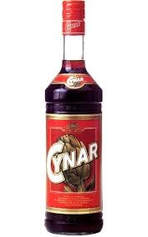 Artichokes not only contain every nutritional device, meme and trope imaginable, every vitamin, folate, fibre, antioxidant (highest level of any vegetable), known for thousands of years. You know the story. But it is particularly useful it seems, for the digestive system and can be delivered to you through a glass of Cynar, a digestive so bitter, it's impossible to imagine it doing you anything but good. It could remove original sin, given a chance along with plague, locusts, boils and pestilence. The plates - any large plate will do, large enough to hold the discarded petals as you eat but... Majolica artichoke plates have been made by the French company Gien since the late 19th C. Mine were collected bit by bit on eBay but date no later than the 1970s. Isabella Blow with shoemaker Manolo Blahnik (Shutterstock) What makes a great host? Someone who invites you! I share Isabella Blow's sentiments... "My style icon is anybody who makes a bloody effort," said Isabella Blow (1957 - 2007) At this time of year we’re inundated with advice on getting through the holiday/party season sanely. Happens every year, year in year out, but are we listening? Well, here we go – more advice. First scenario - You don’t often gather friends around a table so you make up for it by preparing nine courses. They are all small but nine, nonetheless. Let’s face it, we’re all bored by the dégustation menu concept. A mouthful here, mouthful there and nothing big enough to really taste. By the fifth course, I’m bored. Don’t bore your friends. Keep it simple and stay with them at the table with three (at the most four) pre-prepared courses. A plate of asparagus with vinaigrette (or beurre blanc, previous post) is a course. A slice of terrine (bought from the French guy at the market) and a few cornichons (gherkins to you) is a course. A platter of nicely sliced tomatoes, some ripped mozzarella, some basil and olive oil is a course (don’t forget the salt and garlic). A Waldorf salad is a course (think Basil Fawlty). Prosciutto and melon (or figs) is a course. Second scenario – I was asked how I managed the numbers. Their friends and extended family gather for a sumptuous feast of turkey, ham, prawns and up to seven different vegetables and salad. (Imagine for a moment what that all looks like on the plate.) I was asked, so I replied. I suggested that I would just never offer so many choices. She looked beatifically into the distance and sighed, “Ah, but they’ve come to expect it.” TOUGH! It’s not the last supper. After the first course, preferably vegetal (salad), think one protein, one carb, one veg, at the most two. Sounding like a dietician? Well check it out. Once you’ve had cheese or pudding, you’ve got the five food groups covered! And stick the food down the table for guest to help themselves and pass on. You’re not a restaurant, canteen or a pub buffet. It’s friendly to pass, it creates intimacy and helps if conversation is touchy. “Could you pass the chutney?” “Have you had the broccoli?” “I adore mushrooms.” “I shouldn’t, peas make me burp.” Third scenario – we arrive to eight glasses set up on the bench and some delicious toast fingers of chopped egg & top-notch anchovies, another with rare beef & pickled beetroot. After some Champagne we are directed to the table while SH discreetly sets out plates on a bench and pulls a couple of boxes from the refrigerator. She plonks some peeled, grilled capsicum at the bottom of each plate, tops with a ball of pre-wrapped, prosciutto-wrapped buffalo mozzarella. A scattering of oregano leaves, olive oil and voilà. She also removes a platter of thinly sliced cooked veal from the fridge, to allow it to come to room temperature. (Sorry no image. I was too engrossed.) Main course to the table, vitello tonnato, the veal slathered in capers and a tuna mayonnaise, with extra in a sauce boat. Grilled broccolini accompanies as well as a salad of interesting green things, varied peas, beans, strips and leaves – superb. That is it.
After cheese – one perfect Délice de Bourgogne and some candied cumquats – comes a buttery raspberry cake with cream. A perfect lunch for a warm day. We all laughed and gossiped and pledged undying love for friendship and each other. There was no smell of burning martyr. SH is someone who makes a “bloody effort”, and her guests don’t have to suffer for it. Click like and better still, add a comment or suggestion. We were asked to lunch last week. When I walked into the space and saw the table, I knew all would be well - such sensible simplicity and such ease. (No mountains of tinsel and poinsettia crowding the table.)
You'd be hard pressed to find a more beautiful plate. Steph and I used to haunt the auctions where she found (for a song) this vintage pile of Villeroy & Boch - plates, sauceboats and platters. (Haven’t been able to date nor name it yet.) It doesn’t get much better than to be invited to someone’s house. The end of the year, the festive season, whatever you wish to call it, there’s going to be a lot of hospitality going on. And it’s not about the food. We do it because we want to be with each other. So let’s have some open discussion this month on making it all happen, with dignity and grace. Three simple pointers to start with, for both sides… Be the best host/e
Be the best guest.
What are your pointers? Comment below. Sauceboats - they don't pour, they're not meant to pour. Add a spoon, easy and no drips. European sauceboats have attached under-plates. Very sensible. If you can, have two per table. If you're still hunting around the junk shops, use a bowl with a spoon (rather than a jug).  I've long thought that serving fish well, basically boils down to having a lemon and to knowing two sauces - beurre blanc and sauce vièrge (see post 15/12 2018) There has been a lot of feed back on the Coulibiac (November 2018 post), with promises to make one and send photos! In that case, you'll need to try a beurre blanc, the perfect sauce to serve along side. This is not a sauce for fat phobics and margarine eaters. If you think you'd better only have a small serve, perhaps this is not the sauce for you. This sauce relies on technique and understanding. Somehow you are making oil and water emulsify. It's magic. BUT if my kitchen phobic partner can do it, anyone can. It can be made with red wine - nice with steak - and of course it is then a beurre rouge. Beurre Blanc (a tidy serve for 6 to 8) ½ cup white wine 1 spring onion or 1 tbsp finely chopped shallots dash of cream ** 250 gm butter seasoning to taste lemon juice to taste Use a saucepan with a handle so you can easily lift it on and off the heat to monitor the heating temperature. Unfortunately the sauce should be made no earlier than 3/4 hour before serving. Let this be the only last minute thing you have to worry about. Any left over can be eaten the next day spread on toast. **Cream doesn't feature in the classic recipe but Gabriel Gaté suggested it to me as added protection against the sauce splitting.
|
Categories
All
|
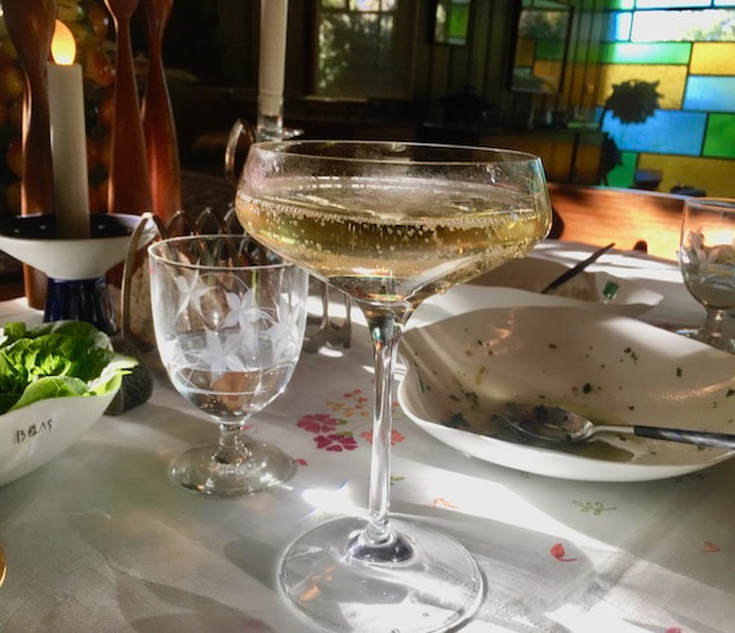
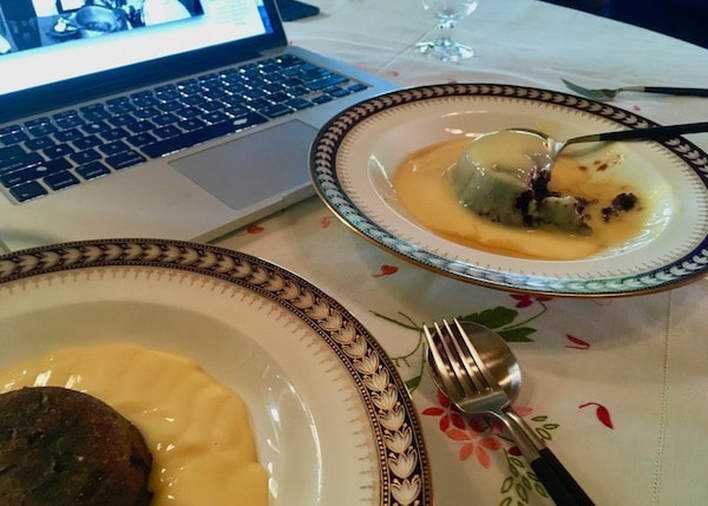
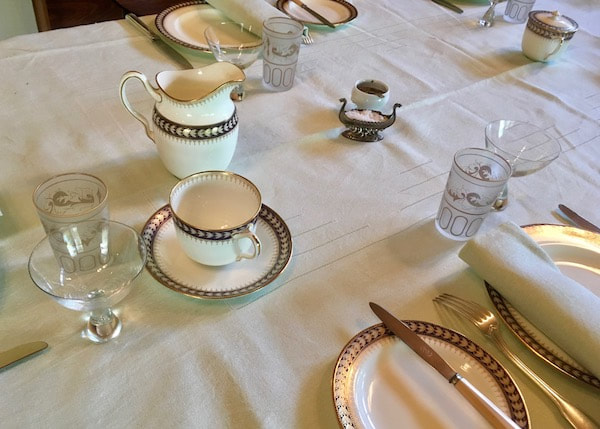
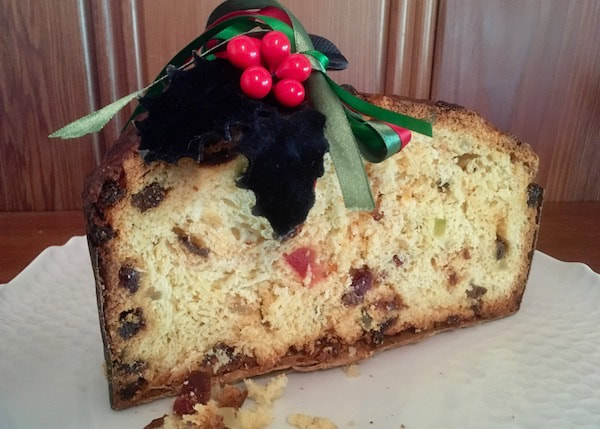
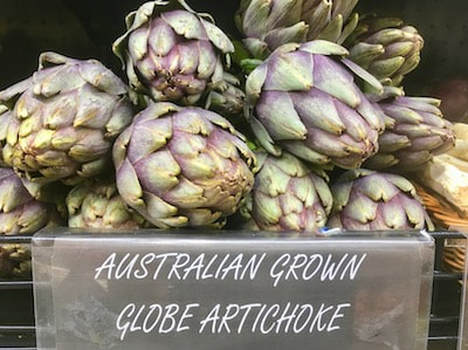
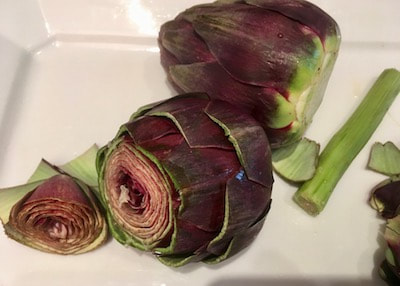
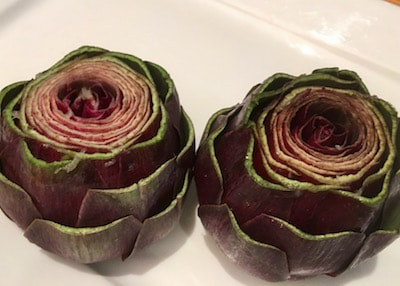
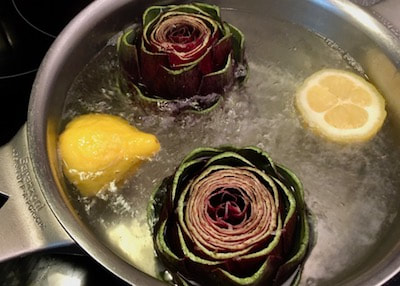
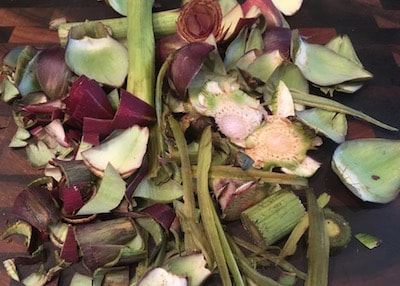
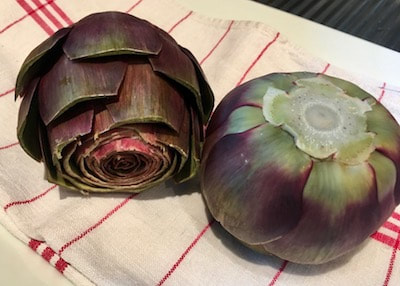
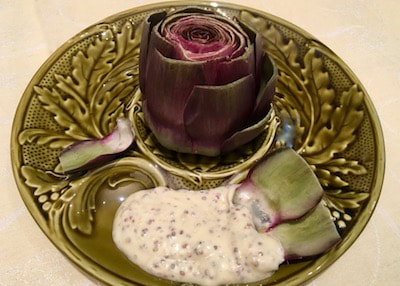
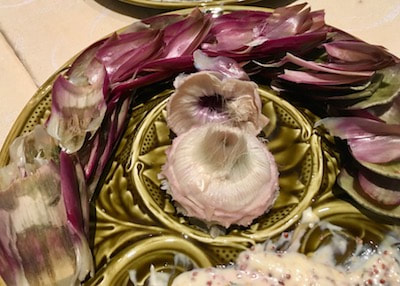



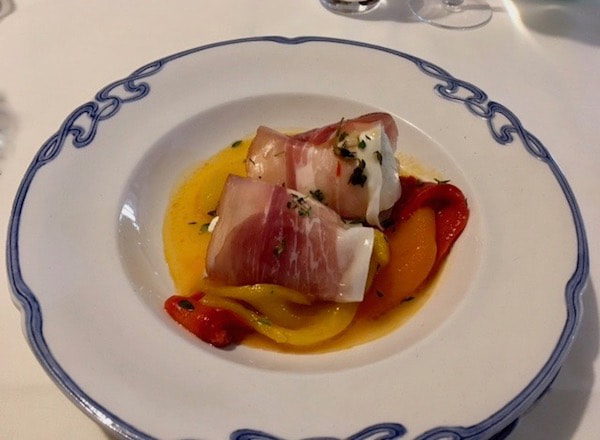
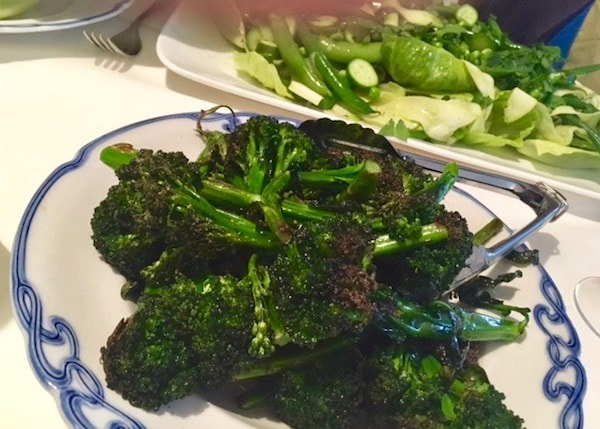
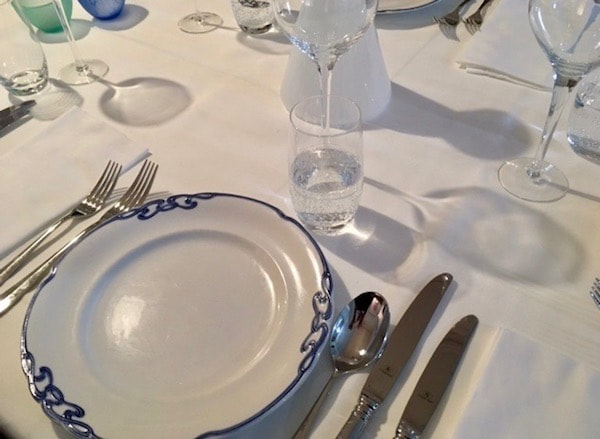
 RSS Feed
RSS Feed
